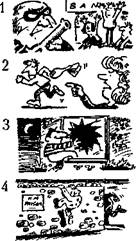POLICE AND CRIME
break in/break into sthg Burglars broke in while we were out
and stole $1000. break out/break out of sthg Six prisoners managed to break out
and run off.
bump sbdy off (slang) Who do the police think bumped
Mr Big off?
catch sbdy out The police caught him out when he
said he was at the cinema: it was closed at the time, do away with sbdy (slang) Someone's done away with him: he's
been shot,
do sbdy in (slang) Ted couldn't have done him in. He
didn't have a gun.
do sbdy out of sthg Katie was done out of $20 by the
dishonest salesman, get away with (a crime, etc.) 'You'll never get away with it,' Tom
told the kidnapper,
get off with (a warning, etc.) He's lucky to get off with a warn
ing and not be fined,
give oneself up The criminals gave themselves up
to the police,
go for sbdy I was so angry that I went for the
burglars with a stick,
hold sbdy up The gang took out their guns and
held us up.
let sbdy off The judge let Mary off as no one
had proved her guilty,
look into sthg The police are looking into the case
of the missing ring,
make off with sthg The thieves opened the safe and
made off with $1000.
D Read the sentences below. Inspector Sharp is talking to a news-per reDorter
We have no definite knowledge of who killed him. However, Mr Sims cheated Bill Low out of a large amount of money. If it's Bill Low, we don't expect he'll surrender to the authorities without a fight.
He attacked a policeman once.
He even escaped with the policeman's gun.
Now read the following sentences. Big Joe, a well-known criminal, is talking to one of his friends. Although Big Joe gives the same information as the inspector, he uses slang and colloquial English. Complete the longer blanks with appropriate verbs and the shorter blanks with particles.
Bigjoe
Someone's1_______ Mr Sims_______ .
I've got no idea who2______ him_____ .
But old Sims3_______ Bill Low__________ a lot of money.
If it's Bill, he won't4_____ himself_______ without a fight.
He5__________ a policeman once.
He even6____________ the policeman's gun.
Ш What do you think is happening in each picture? Write sentences, using a phrasal verb from the list below.
break in hold up break out make off with

В Complete the newspaper extracts, using a suitable phrasal verb from the list at the beginning of this unit. (Use different pnrasal verbs for the two blanks in no. 3.)

Now match the headlines with the extracts. Write the letter of the headline in the space by each article.
6. Study the following text, a) Extract the necessary information about law enforcement in the USA:
A criminal case begins when a person goes to court and files a complaint that another person has committed an offence. This is followed by issuing either an arrest warrant or a summons. A criminal case is started when an indictment is returned by a grand jury before anything else happens in the case. Indictments most often are felony accusations against persons who have been arrested and referred to the grand jury. After an accused is indicted, he is brought into court and is told about the nature of the charge against him and asked to plead. He can plead guilty, which is the admission that he committed the crime and can be sentenced without a trial. He can plead not guilty and be tried.
As a general rule the parties to civil suits and defendants in criminal cases are entitled to trial by jury of 12 jurors. But a jury is not provided unless it is demanded in writing in advance of the trial; in this case a civil or a criminal case is trial to the judge alone, greater criminal cases are tried to a three-judge panel.
In trial by the jury the attorneys for each party make their opening statements. The prosecution presents its evidence based on the criminal investigation of the case.
The attorney for the defence pleads the case of the accused, examines his witnesses and cross-examines the witnesses for the prosecution. Both, the prosecution and the defence, try to convince the jury. When all the evidence is in, the attorneys make their closing arguments to the jury with the prosecutor going first. Both attorneys try to show the evidence in the most favourable light for their sides. But if one of them uses improper material in his final argument the opponent may object, the objection may be ruled out by the judge who will instruct the jury to disregard what was said or may be sustained. After this the judge proceeds to instruct the jury on its duty and the jury retires to the jury room to consider the verdict. In civil cases at least three-fourths of the jurors must agree on the verdict. In a criminal case there must not be any reasonable doubt as to the guilt of the accused, the verdict must be unanimous.
The next stage is for the judge to decide, in case of a verdict of guilty, what sentence to impose on the convict.
b) Use the material of the text and the thematic vocabulary in answering the following questions:
1. Who are the participants in the legal procedure? 2. In what way does a legal procedure start a) in civil cases, b) in criminal cases? 3. Describe the procedure of the trial in the American court of common pleas. 4. What kind of offences are known to you? Specify the felony and misdemeanor. 5. What penalties and sentences are imposed in the US courts?